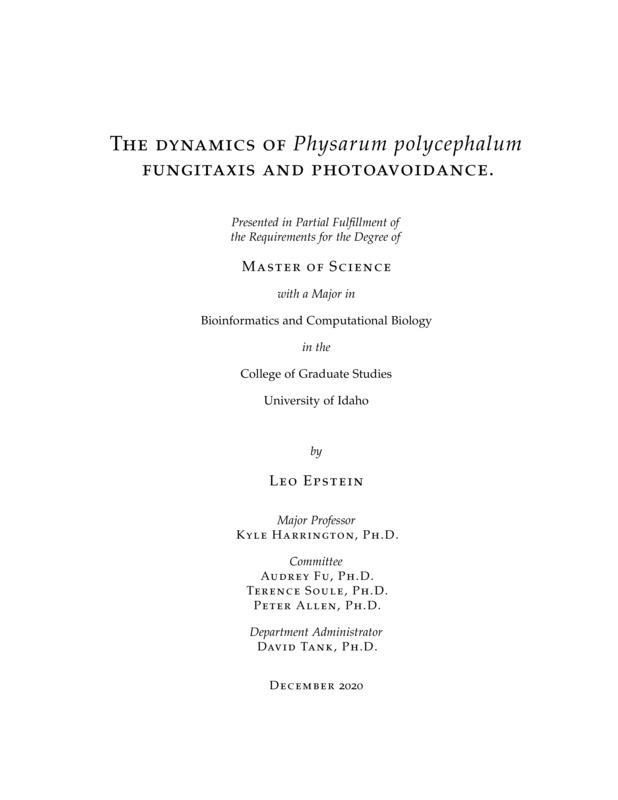The dynamics ofPhysarum polycephalumfungitaxis and photoavoidance.
Epstein, Leo. (2020-12). The dynamics ofPhysarum polycephalumfungitaxis and photoavoidance.. Theses and Dissertations Collection, University of Idaho Library Digital Collections. https://www.lib.uidaho.edu/digital/etd/items/epstein_idaho_0089n_12017.html
- Title:
- The dynamics ofPhysarum polycephalumfungitaxis and photoavoidance.
- Author:
- Epstein, Leo
- Date:
- 2020-12
- Program:
- Bioinformatics & Computational Biology
- Subject Category:
- Bioinformatics
- Abstract:
-
In my thesis I have tried to answer the following questions: What effects do different patterns and amounts of light exposure have on Physarum fungitaxis and morphogenesis? Are the dynamics of Physarum and yeast interaction modulated by light? Can we characterize the Physarum light response and its interactions with a red yeast such that we can input a sequence of light into Physarum's environment such that we can increase or decrease the rate at which it consumes a red yeast (we have not genotyped this micro-organism). Physarum morphogenesis and fungitaxis(how it interacts with a red yeast) were measured using several week-long image sequences taken with flatbed scanners. These images were segmented using the semi-supervised iterative pipeline of U-Net and Ilastik. These semantic (as in we defined elements of the image that should be labeled by the network) segmentations were used to measure the mass and morphology of yeast, oats, and Physarum in all images. With these measurements, we analyzed the interactions shared between Physarum and red yeast. We find that these interactions occur at specific spatial scales. Running our data through the FNN-LSTM autoencoder help us to better understand the dynamics of these interactions. We find that Physarum and yeast interactions are succesional. Physarum maintains yeast as a periodic food source by depositing a nutritive slime trail after it consumes most of the yeast. With these observations we moved on to the other component of our research program, how Physarum morphogenesis is influenced by light exposure. To answer this question we trained a triplet loss embedding (a supervised clustering algorithm that works on user defined/semantic labels). We were unable to generate satisfactory clusters with this embeddinga/clustering algorithm. Individual plasmodia clustered with each other in temporally coherent sequences within the latent space. Instead of constructing a latent space with which we could understand photomorphogenesis and photomovement we found a pathological feature of the Triplet embedding algorithm. With this failure in mind, we tried to construct a morphospace of Physarum morphogenesis. With this morphometric approach, we were unable to find evidence that photoexposure itself shapes Physarum morphogenesis over the course of a week. This observation in some ways contradicts the existing literature in which Physarum avoids blue light and the peristaltic pumping that drives Physarum movement is disrupted by light exposure. It is possible that Physarum habituates to the regime of light exposure and loses sensitivity during the course of an experiment. To investigate this hypothesis, we propose new experiments to better understand the temporal dynamics of photoavoidance (how Physarum avoids a particular region of light) in contrast to photomorphogenesis where its whole environment is illuminated. With these new observations, we may be able to better understand Physarum photoavoidance and its relationship with fungitaxis. We may also be able to characterize a decay in the Physarum photoavoidance response that would in itself be an important result.
- Description:
- masters, M.S., Bioinformatics & Computational Biology -- University of Idaho - College of Graduate Studies, 2020-12
- Major Professor:
- Harrington, Kyle
- Committee:
- Fu, Audrey; Soule, Terence ; Allen, Peter
- Defense Date:
- 2020-12
- Identifier:
- Epstein_idaho_0089N_12017
- Type:
- Text
- Format Original:
- Format:
- application/pdf
- Rights:
- In Copyright - Educational Use Permitted. For more information, please contact University of Idaho Library Special Collections and Archives Department at libspec@uidaho.edu.
- Standardized Rights:
- http://rightsstatements.org/vocab/InC-EDU/1.0/

